Caballero B. (ed.) Encyclopaedia of Food Science, Food Technology and Nutrition. Ten-Volume Set
Подождите немного. Документ загружается.


Thermal Conductivity Detectors (TCD)
0036 These are universal detectors, with a medium sensi-
tivity, and are concentration-dependent. The column
effluent passes through a chamber containing a hot
filament. When a compound appears in the effluent,
the thermal conductivity of the mixture solute/carrier
gas, and hence the heat dissipation velocity, varies;
this causes a temporal variation in filament tempera-
ture and a change in its electric resistance, which is
very easy to measure. The best carrier gases for this
detector are hydrogen and helium. TCD is appropri-
ate for substances such as permanent gases, and can
also be coupled in tandem with other detectors.
Ionization Detectors
0037 These induce sample ionization by using thermal,
chemical, electromagnetic, or radioactive energy.
Solute ions in the carrier gas produce changes in the
electric field between two electrodes. This is shown
schematically in Figure 4.
0038 Flame-ionization detectors These are the most com-
monly used detectors in GC and are almost universal,
with a high sensitivity to organic carbon-containing
compounds, a wide linear range, and an excellent
baseline stability. They are also very reliable, with a
negligible dead volume and a fast response time. The
ionization energy is supplied by a flame, obtained by
a hydrogen flow, which is mixed with the column
effluent. The organic compounds are burnt, produc-
ing H
2
O and CO
2
; the response is proportional to the
solute mass flow and is similar for most organic sub-
stances. Molecules with less C—H bonds than hydro-
carbons give a lower response than hydrocarbons.
These detectors can be used with all carrier gases
and are easy to calibrate.
0039 Electron capture detectors (ECD) These are very
specific and sensitive to compounds with a high elec-
tron affinity. The ionization source is a foil (usually
63
Ni or
3
H), which emits b-radiation. Nitrogen and
an argon/methane mixture are suitable carrier gases
for ECD. A low potential is established between
electrodes, producing a current that decreases when
a solute capable of accepting (‘capture’) electrons
appears in the effluent. The relative response is very
different for compounds that have groups with differ-
ent electronic affinities: e.g., a polychlorinated com-
pound has a response 10
6
times higher than that of
a saturated hydrocarbon. Thus, it is comparatively
easy to detect less than 1 pg of polyhalogenated com-
pounds in the presence of other molecules that have
only C, H, and O atoms. Since the ECD response is
dependent on the sample concentration and electron
affinity of each analyte, calibration using standards is
necessary for quantitative analysis.
Electrochemical Detectors
0040These are designed mainly for the environmental
analysis of substances with heteroatoms like S, N, or
halogens, and these detectors are very specific and
sensitive.
Spectroscopic Detectors
0041Several spectroscopic devices can be coupled with GC
in order to obtain structural information about the
eluting peaks. The most commonly used detectors are
those based on mass spectrometry (MS) (See Chroma-
tography: Combined Chromatography and Mass
Spectrometry; Mass Spectrometry: Applications;
Principles and Instrumentation); and Fourier trans-
form infrared (FTIR); See Spectroscopy: Infared and
Raman.) The former have a high selectivity and
sensitivity. The column effluent is continuously fed
into the ionization chamber of a mass spectrometer,
and a mass spectrum is recorded every few seconds.
GC–MS coupling can be used in two modes: scan, in
which all the ion fragments are collected and regis-
tered, giving structural information about all chroma-
tographic peaks, and selected ion monitoring (SIM),
in which only a few mass fragments are recorded,
improving the signal-to-noise ratio and significantly
reducing the detection limit.
Applications
0042GC has been used to analyze the main constituents of
foods, such as lipids, carbohydrates, or amino acids,
and it is especially useful in the study of minor con-
stituents such as aromas or pollutants.
Food Constituents
0043Lipids GC has been the technique of choice for the
study of fats. It is possible to study the degree of
lipolysis by analyzing the free fatty acid (FFA) profile
or the authenticity of fats and oils by determining the
Carrier gas
+ −
fig0004 Figure 4 Scheme of an ionization detector.
1286 CHROMATOGRAPHY/Gas Chromatography

glyceride fraction, the fatty acid composition, and the
unsaponifiable fraction. FFAs can be studied using
modified polar stationary phases, although fatty
acids are usually determined as fatty acid methyl
ester derivatives; these derivatives are volatile and
easy to resolve on polar phases such as polyesters,
polyethylene glycols and cyanoalkyl silicones. There
is considerable interest in the separation of geometric
isomers of unsaturated fatty acids: the use of very long
capillary columns coated with cyanoalkyl silicones is
the best choice. Direct analysis of triacylglycerols, ini-
tially problematic because of their low volatility, has
improved since the development of fused silica capil-
lary columns with a thin layer of stationary phase with
high MAOT values; to date, very good separations
have been reported, based on the number of carbon
atoms and even on unsaturations. The injection of
high-molecular-weight triacylglycerols requires the
use of a cold-on column or PTV injection.
0044 Carbohydrates GC is used to separate mono-
saccharides, disaccharides, and oligosaccharides.
Although the preparation of volatile derivatives
is necessary, the advantage that GC affords over
HPLC is its greater sensitivity and higher resolution.
The most popular derivatives are silyl ethers, oximes,
methyl ethers, and acetates. Silicones ranging from
methyl to cyanoalkyl are the preferred stationary
phases. These methods have been used for juices,
milk, molasses, honeys, and beverages.
0045 Amino acids These have to be derivatized to achieve
a sufficient volatility. The carboxylic group is usually
esterified, and the amino group can be acylated or
silylated.
0046 Minor constituents Sterols are determined in order
to assess food authenticity, especially with fats and
oils, since the sterol composition is characteristic of
each species. They can be analyzed, either as free
sterols or as trimethyl silyl ethers, using packed
columns (methyl or phenyl silicones), but they are
better resolved on capillary columns. Naturally oc-
curring wax esters (from C
24
to C
48
) have been ana-
lyzed using stable thin-film capillary columns.
0047 Volatiles Volatile components are difficult to ana-
lyze because they are usually present as very complex
mixtures at very low concentrations. Thus, the first
requirement is the use of high-resolution columns:
these are long, well-deactivated capillaries, coated
with nonpolar (methyl or methyl vinyl silicones)
or medium polar (polyethylene glycols) phases
in order to elute hydrocarbons, alcohols, esters, pyr-
azines, aldehydes, acids, etc. High-resolution gas
chromatography coupled with MS and sometimes
with other spectrometric detectors like FTIR detect-
ors allows the successful analysis of complex mix-
tures and the identification of many new
compounds. A data-acquisition system is suitable for
profile analysis and computer-based pattern recogni-
tion. A prior isolation and concentration step is usu-
ally necessary in order to suppress the matrix.
Different off-line or on-line techniques can be used:
these are based on extraction, static headspace, ther-
mal desorption, and purge-and-trap devices.
0048Chiral compounds GC affords excellent separations
of enantiomeric pairs, due to the high efficiency of
capillary columns. Commercial columns are prepared
with d-orl-valine tert-butylamide derivatives, metal
complexes, or substituted cyclodextrins. They have
been used to determine the racemization of amino
acids, to detect adulterations in several food products
by analyzing the enantiomeric purity of marker com-
pounds, and to assess the aging or thermal processing
of different foods.
0049Permanent gases CO
2
and SO
2
, present in certain
beverages or wines, can be determined using packed
or SCOT columns and TCDs.
Pollutants
0050GC is the basic method used to detect and analyze the
presence in foods of pollutant residues, such as pesti-
cides, toxaphenes, polychlorinated biphenyls (PCBs),
polycyclic aromatic hydrocarbons (PAHs), chlorin-
ated solvents, polychlorodibenzodioxins (PCDDs),
and polychlorodibenzofurans (PCDFs). Multiresidue
procedures are used more frequently than specific
methods. Analysis of these substances, which are pre-
sent at p.p.b. or p.p.t. levels, requires several extrac-
tion, clean-up, and purification steps. High-purity
solvents and reagents must be used, and glassware
has to be cleaned with special care to avoid introduc-
ing new residues. High-efficiency capillary columns
are recommended; this is especially true for PAHs,
which can be resolved efficiently using liquid crystal
phases, and for chiral PCBs. Selective detectors are
required for all of these compounds. Chlorinated
compounds are detected using ECDs; organophos-
phorus compounds are better detected using thermo-
ionic or flame-photometer detection. MS detectors
working in the SIM mode are useful for all pollutants.
Those present at very low levels, such as PCDDs
and PCDFs, require high-resolution MS or MS–MS
systems to be selectively characterized. (See Contam-
ination of Food; Pesticides and Herbicides: Residue
Determination; Pesticides and Herbicides: Types of
Pesticide.)
CHROMATOGRAPHY/Gas Chromatography 1287

Other
0051 GC allows analysis with very low detection limits of
different substances such as illegal drugs used in cattle
fattening, N-nitrosamines, residues in food deriving
from plastic packaging, additives like antioxidants,
preservatives, certain colorants, and other food
ingredients
See also: Chromatography: Combined Chromatography
and Mass Spectrometry; Contamination of Food; Mass
Spectrometry: Principles and Instrumentation;
Applications; Pesticides and Herbicides: Types of
Pesticide; Residue Determination; Spectroscopy:
Infrared and Raman
Further Reading
Biermann CJ and McGinnis GD (1989) Analysis of Carbo-
hydrates by GLC and MS. Boca Raton, FL: CRC Press.
Christie WW (1989) Gas Chromatography and Lipids. Ayr,
UK: The Oily Press.
Grob K (1986) Classical Split and Splitless Injection in
Capillary GC. Heidelberg: Hu
¨
thig.
Guiochon G and Guillemin CL (1988) Quantitative Gas
Chromatography. Amsterdam: Elsevier.
IUPAC (1993) Nomenclature for chromatography. Pure
and Applied Chemistry 65: 819–872.
Ko
¨
nig WA (1992) Gas Chromatographic Enantiomer
Separation with Modified Cyclodextrins. Heidelberg:
Hu
¨
thig.
Marsili R (1997) Techniques for Analyzing Food Aroma.
New York: Marcel Dekker.
Rotzsche H (1991) Stationary Phases in Gas Chromatog-
raphy. Amsterdam: Elsevier.
Sandra P (1985) Sample Introduction in Capillary Gas
Chromatography, vol. 1. Heidelberg: Hu
¨
thig.
Scott RPW (1996) Chromatographic Detectors. New York:
Marcel Dekker.
Shibamoto T (1998) Chromatographic Analysis of Envir-
onmental and Food Toxicants. Amsterdam: Elsevier.
Wittkowski R and Matissek R (1993) Capillary Gas Chro-
matography in Food Control and Research. Lancaster,
PA: Technomic.
Supercritical Fluid
Chromatography
J W King, Los Alamos National Laboratory,
Los Alamos, NM, USA
Copyright 2003, Elsevier Science Ltd. All Rights Reserved.
Background
0001 Supercritical fluids are unique substances that exhibit
physical properties that are intermediate between
those of a gas or liquid. Their density can be adjusted
by regulating the pressure or temperature of the fluid,
thereby allowing the fluid’s density to range from that
of a dilute gas to liquid-like values. Such a variation in
density accounts for the adjustable, liquid-like prop-
erties that these fluids exhibit when used for extrac-
tion and for separation purposes. Mass transport
properties of supercritical fluids (SFs) also exhibit
values that are in between those of gases and liquids,
but in general, properties like solute diffusion coeffi-
cients in SFs are more gas-like than liquid-like in
magnitude. These favorable characteristics allow SFs
to readily penetrate samples, thereby allowing for
rapid dissolution and high flux rates of solutes into
the SFs.
0002The supercritical fluid region is usually defined in
the upper right region of a pressure and temperature
phase diagram by a substance’s critical points, the
critical pressure (P
c
) and critical temperature (T
c
).
This is shown in Figure 1 for carbon dioxide (CO
2
),
the substance usually utilized in supercritical fluid
extraction (SFE) and supercritical fluid chromatog-
raphy (SFC). Above a pressure of 7.38 MPa (1070
psig) and a temperature of 31
C, carbon dioxide
will always be in its supercritical state (SC-CO
2
)no
matter what external pressure is applied to CO
2
. This
relatively low T
c
,CO
2
’s high nonideality, and its
relative environmentally benign nature, make CO
2
the fluid of choice for SFC and SFE.
0003The application of SFC to foods and nutritional
analysis came about naturally owing in part to the
early application of SC-CO
2
extraction in the food
industry, i.e., for the extraction of coffee, hops, and
similar food items used routinely by the consuming
public. As will be demonstrated, SFC is particularly
applicable for the analysis of lipid-containing
Triple point
CO
2
gas
Pressure
Critical pressure
1070 psig
Liquid CO
2
Critical point
Solid CO
2
(Dry ice)
Supercritical
fluid
Temperature
Critical
temperature 31 ⬚C
fig0001Figure 1 Pressure and temperature phase diagram for carbon
dixoide.
1288 CHROMATOGRAPHY/Supercritical Fluid Chromatography
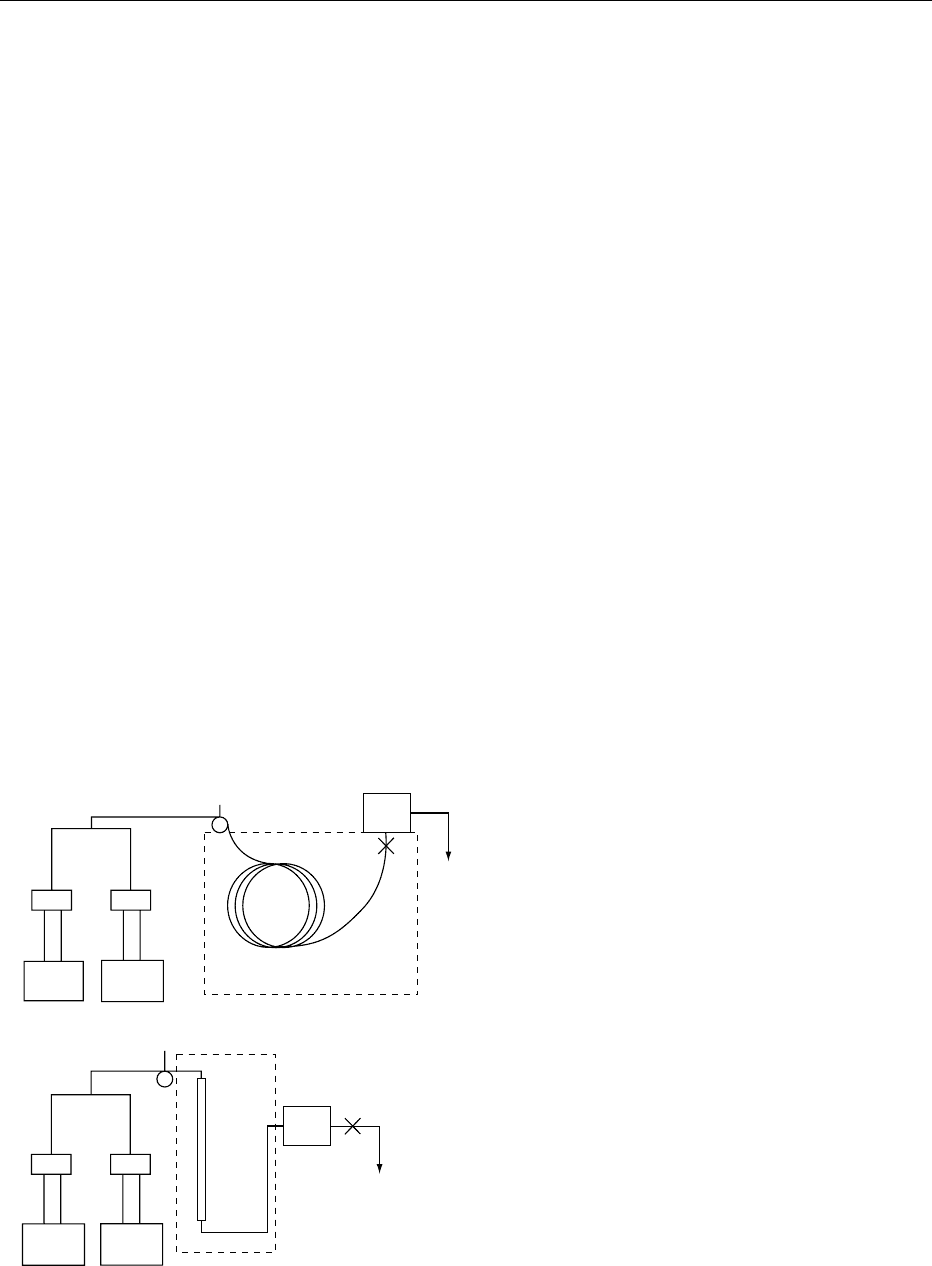
materials, owing to relative high solubilities exhibited
by these solutes (analytes) in SC-CO
2
. Analysis and
detection of ultratrace components in foodstuffs, e.g.,
pesticides or drugs, has not generally been successful
owing to the problems in routinely interfacing and
using sensitive detectors, such as the electron capture
detector with SFC, owing to the change in mobile
phase characteristics with respect to time during an-
alysis. However, the ability to routinely use the flame
ionization detector (FID) with SFC has provided the
analyst with a useful technique to detect an array of
components, or a specific moiety in a complex food
matrix.
0004 With respect to the chromatographic technique
utilized, it was initially the capillary mode of SFC
that was cited more often than packed column SFC
for the analysis of foods. This has changed somewhat
in recent years, however, particularly with the advent
of using packed column SFC for the analysis of chiral
compounds. This has created more opportunities for
applying SFC using packed columns in food analysis,
since a knowledge of the chirality of a compound can
be of importance even in the food industry (e.g.,
flavor esters). Figure 2 shows the basic schematic
for a capillary SFC (a) and a packed column SFC
(b) instrument. The components making up the
instrumentation for both modes of SFC are very
similar: dual pumps for the SFs and cosolvent (or
modifier), respectively; columns contained inside a
thermostatted oven and detectors external to the
oven. However, in the case of the capillary SFC, the
fluid is depressurized directly into the detector,
whereas in the packed column case, the detector is
usually maintained under pressure, before it is dis-
charged to waste (W). In the packed column mode,
the SFC can be interfaced with a ultraviolet detector
(UV), evaporative light-scattering detector (ELSD), or
a mass spectrometer. In general, the coupling of ana-
lytical supercritical fluid extraction (SFE), on-line
with SFC, has not been adopted to any considerable
extent by food analysts, owing to the lack of an
interface that permits routine coupling for use of the
SFE/SFC mode. However, preparative and produc-
tion-scale SFC have been utilized for specialized appli-
cations in the food-production industries and will
probably see increased use owing to the current interest
in producing high-value nutraceutical components, in
a ‘natural’ and environmentally benign manner.
0005SFC is perceived as a niche technique in the food
industry, so it is critical to recognize when and where
it can be used to advantage relative to what can be
achieved using other forms of chromatography, such
as gas chromatography (GC) and high-performance
liquid chromatography (HPLC). (See Chromatog-
raphy: High-performance Liquid Chromatography;
Gas Chromatography.) Some of these opportunities
are as follows:
.
0006reduction of the use of organic solvents relative to
HPLC;
.
0007direct analysis of samples avoiding sample prepar-
ation step;
.
0008deformulation of commercial food products;
.
0009detection of product adulteration or deterioration;
.
0010support of food engineering extraction/reaction
process development.
With respect to nonpolar solutes, pressure- or dens-
ity-programmed SFC provides the capability to
analyze compounds having molecular weights ap-
proaching 1200 Da using one chromatographic an-
alysis. Separation of these compounds by SFC is a
function of their solubility in the mobile phase, their
respective vapor pressures, and the miscibility pres-
sure/temperature of the solute in the fluid phase. For
example, in Figure 3, a diverse number of components
have been separated using the capillary SFC method,
that traditionally would have required the use of
either GC or HPLC, as well as derivatization of
some of the analytes. Utilizing SFC allows the analyst
to avoid using either of both GC or HPLC, and
to directly analyze the sample, obtaining a ‘snapshot’
of the entire molecular composition of the sample.
These characteristic elution patterns produced using a
SFC can be used as means of identifying the presence
SCF
Modifier
SCF
(a)
(b)
Modifier
Oven
Oven
Column
Column
Detector
Detector
W
Injector
Injector
High
pressure
pumps
High
pressure
pumps
W
fig0002 Figure 2 Schematic diagram of (a) capillary SFC, and
(b) packed column SFC.
CHROMATOGRAPHY/Supercritical Fluid Chromatography 1289
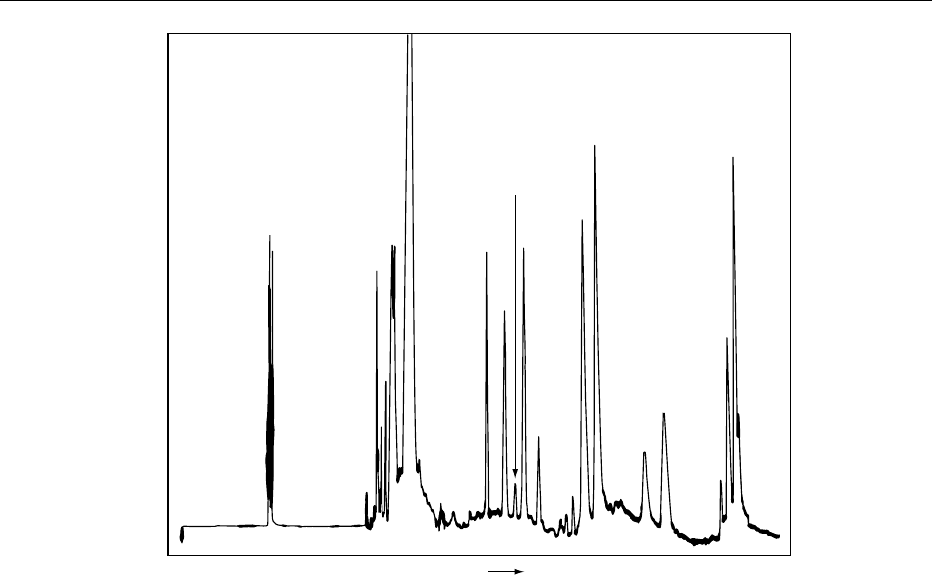
or absence of a particular analyte in a food sample,
thereby providing valuable information for a food
product formulator, to match or alter, in developing
new and competitive food-related products.
0011 Increasing concerns about minimizing or eliminat-
ing the use of hazardous organic solvents in the
laboratory also bodes well for use in SFC. By incorp-
orating SFC for the separation and detection of food-
related solutes, one not only eliminates most of the
traditional solvent needs associated with HPLC, but
potentially solvents utilized in the extraction or
sample workup steps prior to analysis. In this regard,
SFC is an excellent tool for monitoring the end result
of an extraction or reaction of a food component
using supercritical fluid media. Also, by using SFC,
food-related analytes that are thermally labile or sus-
ceptible to degradation via oxidation are not exposed
to the harsh conditions that often accompany their
analysis by GC or HPLC. Such an advantage can be
attributed to the protective action of SC-CO
2
, which
excludes oxygen, and the low temperatures used when
separating components via SFC.
Selecting and Optimizing SFC Separation
Conditions for Food Components
0012 For the SFC analysis of food-related samples, the
analyst will undoubtly want to start with a general
fluid programming sequence to separate as many
components in the sample matrix as possible. These
programs are executed for an extended time to assure
optimum resolution and detection of the unknown or
target analyte(s). Run times of 1.5 h in length are not
unusual in this beginning stage of method develop-
ment for SFC separations. After the target analyses
have been identified by retention time matching with
standards, or via an independent method such as mass
spectrometry (MS), the original program can be
modified to reduce the analysis time or improve the
resolution within the chromatogram. Usually, changes
in the mobile phase program will be executed to
hasten the elution of early or late eluting components
that are of no importance for the analysis.
0013Because of the molecular complexity exhibited by
many food ingredients or compositions, it is not
unusual to have a temperature gradient with respect
to time, superimposed on the mobile phase pressure
program during the SFC run. For example, separation
of the like-carbon number triglycerides in soybean oil
is not possible by pressure or density programming
alone, but by superimposing a temperature gradient
during the analysis, these oil components can be sep-
arated quite well. SFC analysis under isobaric condi-
tions is limited in application when analyzing foods,
but it should not be overlooked, since it can yield
often the most precise and accurate results.
Time
FID response
Fatty acids
Squalene
δ-tocopherol
β-tocopherol
γ-tocopherols
α-tocopherol
Diglycerides
Phytosterols
Triglycerides
fig0003 Figure 3 Supercritical fluid chromatography analysis of deodorizer distillate with a SB-octyl-50 column using flame ionization
detection.
1290 CHROMATOGRAPHY/Supercritical Fluid Chromatography

0014 By far, the FID has been the most used detector
used to date in SFC. FID sensitivity to food compon-
ents is lower than that obtained using GC, since ex-
pansion of the mobile phase dilutes the detector signal
substantially. However, the FID signal can be ampli-
fied to permit analysis down to the p.p.m. level, pro-
vided that baseline shifts can be compensated for.
Analytes with chromaphoric properties are amenable
to analysis using the ultraviolet (UV) detector in
conjunction with SFC. The absorption maxima of
components shifts as a function of fluid density or
pressure, but most detector units constructed for op-
eration at these elevated pressures allow for stop flow
or in situ, on-the-fly scanning of peaks to determine
absorbance maxima shifts. Bathochromic shifts of
15–20 nm have been recorded for carotenoids in SC-
CO
2
over a 25-MPa pressure interval. The mating of
the ELSD detector with SFC has been reported by
several investigators, but the day-to-day stability is
inferior to that obtained with HPLC–ELSD couplings
when applied to food analysis. Heteroelement spe-
cific detectors, such as the electron capture or flame
photometric detector, have been utilized mostly in
research studies using SFC and have not been adopted
for routine analysis. The detector sensitivity and
stability under SFC conditions limit their sensitivity
at best to the p.p.m. range.
0015 Many of the promising applications of capillary
SFC have utilized nonpolar bonded phases utilizing
siloxane functionalities as methyl, octyl, phenyl, and
biphenyl in a polymeric form. The weak elutropic
strength of neat SC-CO
2
has favored the use
of short-chain-length, monomeric silance-modified
columns having C
1
,C
4
,C
18
, phenyl, amino, and
diol phases for packed column SFC. The choice of
these phases is not so much related to their selective
interaction with food-related solutes, but to their sur-
face-modifying properties, which reduce peak tailing
and solute interaction with the base silica matrix.
Polymer resin columns have also been utilized, but
they are susceptible to voiding unless specifically
packed for use under supercritical fluid conditions.
Types of food Ingredients Analyzed by
SFC
0016 A myriad of food-related components and matrices
have been analyzed by SFC, as indicated by the partial
listing in Table 1. These include naturally occurring
ingredients such as fats/oils, spices, etc., minor un-
wanted constituents like pesticides, antibiotic drugs,
and mycotoxins, and specific food components, in-
cluding nutraceuticals and flavoring aids. Inspection
of Table 1 indicates a preponderance of applications
in the lipid analysis area. Indeed, SFC is tailor-made
for lipid analysis, although somewhat lacking in the
high-resolution capabilities demonstrated by high
temperature GC. The retention pattern for typical
lipid solutes in SFC as shown in Figure 4, follow a
distinct pattern governed approximately by the
solute’s molecular weight/volatility characteristics.
Elution of the following classes of lipids occurs in
the following order: fatty acid methyl esters, free
fatty acids, hydrocarbons, vitamins, sterols, wax
esters, mono- and then diglycerides, followed by tri-
glycerides and steryl esters. Although there is some
tbl0001Table 1 Food components separated and analyzed by SFC
Carbohydrates: Derivatized corn syrups, mannose glycans
Chiral compounds: Monoterpenes, pyrazines, clenbuterol
Drugs/antibiotics: Caffeine, erythromycin, polycyclic ether
antibiotics, sulfonamides, assorted steroids
Hydrocarbons: Sesquiterpenes, squalene, waxes and wax
esters
Lipids: Fatty acids, fatty acid esters, monoglycerides,
diglycerides, triglycerides, sterol esters, sterols (cholesterol),
fat-soluble vitamins, tocopherols, phospholipids (lecithin), lipid
hydroperoxides, glycolipids
Nutraceuticals: Valeriana, gingolides, sawtooth palmetto berry
Oils/fats: Celery oil, coconut, fish, soybean, wheat germ, palm
oil, rice oil, milk/cheese triglycerides
Packaging/film components: Polypropylene oligomers,
polyvinyl chloride, phenolic antioxidants, low-molecular-
weight polystyrene
Pesticides: Halogenated, organophosphorus, carbamate,
pyrethrins, acidic phenoxy herbicides, sulfonyl ureas
Pigments: Carotenoids, xyanthophyls
Speciality ingredients: Hops components
Spices/flavors: Capsicum, cardoman, coumarin, curry, garlic
components, marjoram, rosemary, vanillan
Terpenes/essential and fruit oils: Grapefruit oil, limonenes,
mint, lemon
Other toxicants: Mycotoxins, nitrosamines, polycyclic aromatic
hydrocarbons
Retention time
Waxesters
Cholesterol
Squalene
Triglycerides
Etherlipids
Cholesterolesters
Diglycerides
Free
fatty
acids
Vita-
mins
fig0004Figure 4 General elution order (retention time) of lipids in SFC
on nonpolar stationary phases.
CHROMATOGRAPHY/Supercritical Fluid Chromatography 1291
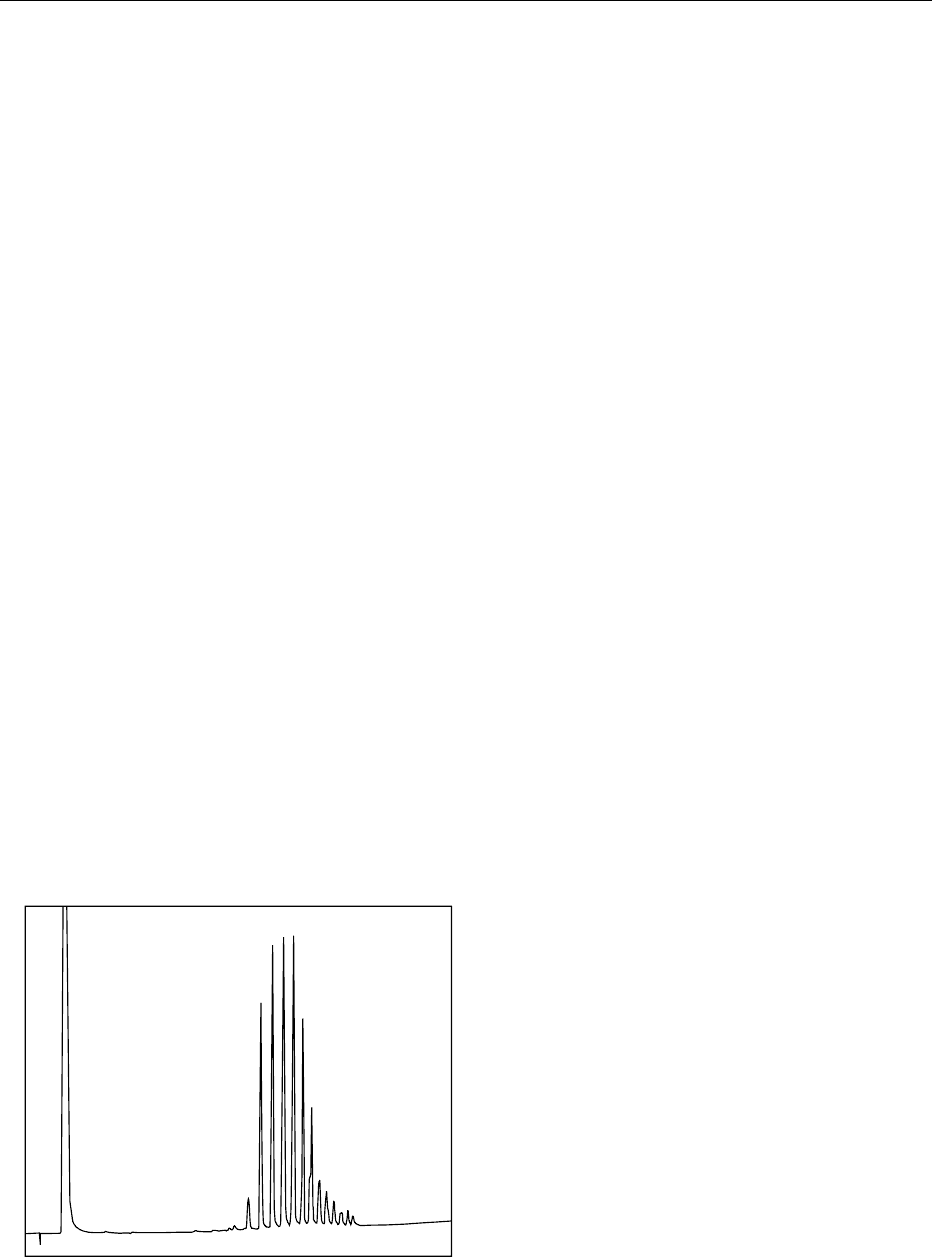
overlap between individual classes of the above
solutes, owing to the overlapping molecular weight
ranges (e.g., triglycerides and steryl esters), this solute
separation pattern has proven very useful in tracking
conversion of lipid species undergoing reactions, as
well as in the quality control of food ingredients.
0017 Triglyceride-based oils/fats are also readily amen-
able to analysis by SFC. Separation of the individual
components is once again governed by molecular
weight considerations, allowing SFC to facilitate
the separation of the major triglyceride species, i.e.,
T
50
,T
52
,T
54
, etc. For some oils, such as coconut oil,
picturesque chromatograms result (Figure 5), as
shown by the separation of the C
18
to C
54
saturated
triglycerides as equally spaced peaks. For other oils
such as soybean oil, there is some overlap between the
saturated and unsaturated triglyceride species, requir-
ing, as noted previously, a superimposition of a tem-
perature gradient along with the pressure gradient
program to achieve adequate resolution. However,
even without high resolution, the rapid SFC analysis
can be used to advantage in quality control, where
speed, rather than optimal separation, is often desired.
0018 Detection of minor components in foods is limited
by the detector sensitivity and stability as noted pre-
viously, but those components that can be detected by
using FID, UV, or ELSD, are often analyzed more
rapidly by SFC, owing to the time savings afforded
by avoiding elaborate preparation of the sample prior
to analysis. In addition, SFC analysis provides a more
detailed profile of the entire sample in addition to
detecting the target analyte. This allows an accurate
assessment of the total contribution of the minor
constituent to the entire ingredient profile, e.g., the
presence of sterol esters in sawtooth palmetto berry
extracts, where the fatty acids and triglycerides are
the major constituents.
0019Other food sample types that can be readily ana-
lyzed by SFC are the fat-soluble vitamins, essential
and flavor oil ingredients, spice extracts, hop com-
ponents, as well as functional food components, i.e.,
nutraceuticals. Some SFC-based separations require
the use of a cosolvent (usually 5–20 vol.%), in add-
ition to the SC-CO
2
, to modify the mobile phase. For
example, phospholipids are only sparingly-soluble in
neat SC-CO
2
, but these polar lipid compounds can
be chromatographed successfully on packed silica
columns by incorporating ethanol and/or water as a
modifier into the mobile phase. Likewise, carbohy-
drate moieties, which exhibit limited or no solubility
in SC-CO
2
or SC-CO
2
/cosolvent mobile phases, can
be derivatized so that they can be analyzed by SFC.
Selected Applications of SFC in Food and
Nutritional Analysis
0020In this section, several brief examples will be given to
illustrate the utility and potential of SFC for food and
nutritional analysis. As noted previously, both high
and low resolution of solutes are possible using SFC.
SFC separation and detection of a-tocopherol and
cholesterol in a fish oil capsule can be achieved on a
capillary SB-methyl column at 120
C, using a density
program with SC-CO
2
from 0.28 to 0.66 g ml
1
and a
density programming rate of 0.0006 g ml
1
. Al-
though the analysis took 90 min to perform, it
allowed the analyst to avoid any sample preparation,
other than diluting the oil from the capsule in small
quantity of solvent, and injecting it into the SFC.
Therefore, no derivatization of the sample was re-
quired, and there was sufficient resolution between
the a-tocopherol and cholesterol to quantify these
analytes. This was made possible by adjustment of
the elution conditions, i.e., the background compon-
ents (fish oil triglycerides), that were of no interest in
this analysis, and were programmed off the column
without resorting to a prefractionation of the sample
prior to SFC analysis.
0021Not all applications of SFC require the above high-
resolution separation. Packed column SFC (5 mm, C
8
– Deltabond) has been used to ‘clean up’ samples
prior to other types of chromatographic analysis
(GC). In this case, organochlorine- and phosphorus
pesticides extracted by SFE with SC-CO
2
from a meat
sample were separated from the coextracted fat moi-
eties using the packed SFC column. Hence, by ‘heart
cutting’ the appropriate elution fraction, a lipid-free,
pesticide-containing fraction was provided for
residue analysis by GC.
Time (density)
120 ⬚C
FID response
fig0005 Figure 5 Capillary supercritical fluid chromatogram of coconut
oil triglycerides.
1292 CHROMATOGRAPHY/Supercritical Fluid Chromatography
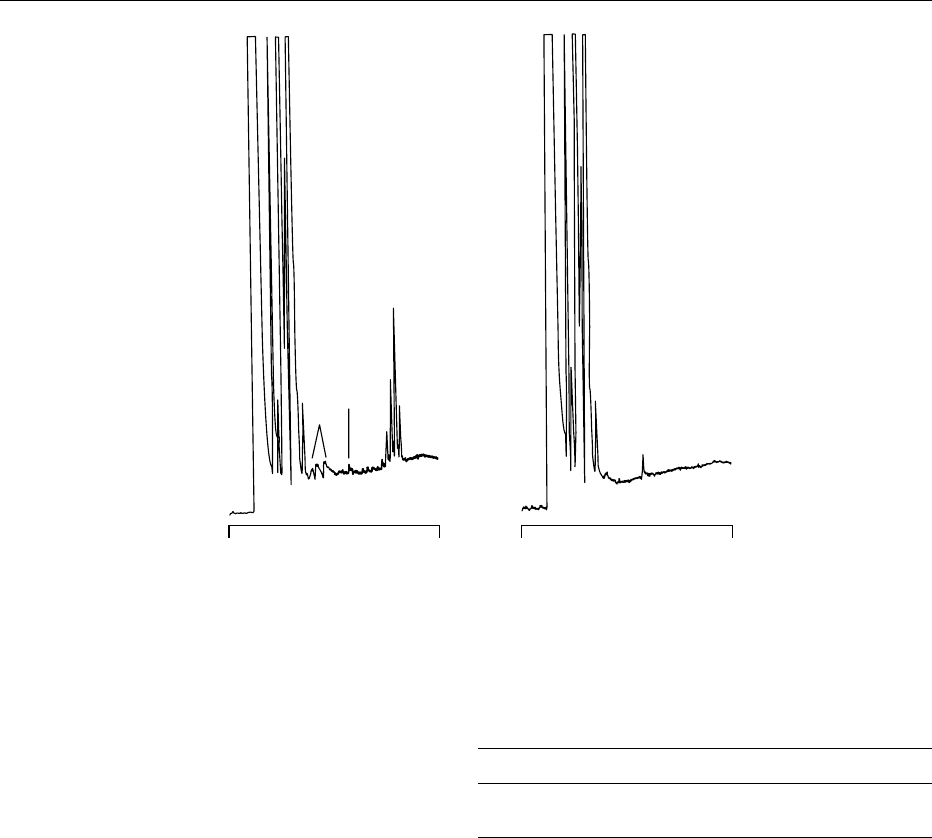
0022 SFC is an excellent technique to monitor reaction
chemistry between lipid species, since it avoids the
need to employ more than one analytical technique
or analyte derivatization. Further, it permits the
successful chromatography of all of the relevant
reactants and products using one chromatographic
analysis. Examples where SFC has been applied are
for the esterification or transesterification of lipids,
glycerolysis reactions, and randomization of fats/oils.
Figure 6 shows two SFC profiles for the enzymatic-
catalyzed transesterification reaction between the tri-
glycerides from a ground beef sample and methanol,
to produce the corresponding fatty acid methyl esters
(FAMEs) for nutritional labeling analysis. The 30-min
chromatograms show the effect of the moisture con-
tent of the ground beef sample on the yield of FAMEs,
(a) being the yield from the neat ground beef sample,
and (b) being the conversion attained by freeze-drying
the sample matrix prior to methanolysis. Note that
freeze-drying of the ground beef was crucial to
obtaining a quantitative yield of FAMEs for fat an-
alysis required in nutritional labeling. The transester-
ification reaction in this case was run in a flow
extractor-reactor in which the ground beef triglycer-
ides were extracted using SC-CO
2
and carried over a
bed of supported lipase in the presence of methanol to
produce the desired FAMEs.
0023Table 2 shows the analysis of the glyceride content
of a soybean oil glycerolysis mixture by both HPLC-
FID and SFC-FID. The information desired was the
relative amounts of free fatty acids (FFA), mono-
(MAG), di-(DAG), and triacylglycerols (TAG) in
the reaction mixture. A comparison of the SFC-FID
results with those obtained by HPLC-FID shows a
relatively good agreement between the two methods.
However, the SFC method does not require the time
and effort for sample preparation associated with the
alternative technique, and in addition saves on the
cost of solvents and chemical reagents.
0024Although mentioned previously, preparative or
production-scale SFC is now being used as a separ-
ation technique in the food industry. Fractionation
and isolation of food components, such as toco-
pherols and phospholipids, or the o-fatty acids/esters
from fish oils, have been cited in the literature.
Time (min)
FID response
FAMES
FAMES
Fatty acids
Cholesterol
Cholesterol
Triglycerides
Time (min)
0
(a) (b)
30 0 30
fig0006 Figure 6 SFC analyses of reaction products from the transesterification of ground beef lipids: (a) neat ground beef sample;
(b) freeze-dried ground beef sample.
tbl0002Table 2 Analysis of lipid species in a soybean oil glycerolysis
mixture
Methodofanalysis MAG DAG TAG FFA
SFC – FID 75.3 23.2 <0.1 1.5
GC – FID 76.2 21.8 <0.1 2.0
CHROMATOGRAPHY/Supercritical Fluid Chromatography 1293

Recently, a production plant for the separation of fish
oil ethyl esters has been constructed in Spain to pro-
duce 95% pure polyunsaturated fatty acids for the
nutraceutical market. The basic separation premise
upon which this production scale plant is designed
was based on chromatographic fractionations ini-
tially developed using analytical-scale, packed SFC
columns.
See also: Chromatography: Thin-layer Chromatography;
High-performance Liquid Chromatography; Gas
Chromatography
Further Reading
Anton C and Berger C (eds) (1997) Supercritical Fluid
Chromatography with Packed Columns. New York:
Marcel Dekker.
Caude M and Thiebaut D (eds) (1999) Practical Supercrit-
ical Fluid Chromatography and Extraction. Amsterdam:
Harwood Academic.
Chester TL (1997) Chromatography from the mobile-phase
perspective. Analytical Chemistry 69: 165A.
Dean JR (ed.) (1993) Applications of Supercritical Fluids in
Industrial Analysis. Boca Raton, FL: CRC Press.
King JW (1990) Applications of capillary supercritical fluid
chromatography – supercritical fluid extraction to nat-
ural products. Journal of Chromatographic Science 28: 9.
King JW (ed.) (1996) Supercritical fluid extraction and
chromatography. Seminars in Food Analysis 1: 101–
116, 133–144, 163–165.
King JW, Hill HH, Jr and Lee ML (1993) Analytical super-
critical fluid chromatography and extraction. In: Rossi-
ter BW and Baetzold RC (eds) Physical Methods of
Chemistry, Supplement and Cumulative Index, 2nd
edn., vol. X. New York: John Wiley.
King JW and List GR (eds) (1996) Supercritical Fluid
Technology in Oil and Lipid Chemistry. Champaign,
IL: AOCS Press.
Lee ML and Markides KE (eds) (1990) Analytical Super-
critical Fluid Chromatography and Extraction. Provo,
UT: Chromatography Conferences.
McDonald RE and Mossoba MM (eds) (1997) New Tech-
niques and Applications in Lipid Analysis. Champaign,
IL: AOCS Press.
Markides KE and Lee ML (eds) (1988, 1989) SFC Applica-
tions. Provo, UT: Brigham Young University Press.
Nam KS and King JW (1994) Coupled SFE/SFC/GC for
the trace analysis of pesticide residues in food samples.
Journal of High Resolution Chromatography 17: 577.
Saito M, Yamauchi Y and Okuyama T (eds) (1994) Frac-
tionation by Packed Column SFC and SFE. New York:
VCH.
Smith RM (ed.) (1988) Supercritical Fluid Chromatog-
raphy. London: Royal Society of Chemistry.
Wenclawiak B (ed.) (1992) Analysis with Supercritical
Fluids: Extraction and Chromatography. Berlin:
Springer.
Combined Chromotography
and Mass Spectrometry
F A Mellon, AFRC Institute of Food Research, Norwich,
UK
Copyright 2003, Elsevier Science Ltd. All Rights Reserved.
Introduction
0001Techniques of combined chromatography/mass spec-
trometry are widely used in food analysis and have
been applied to the solution of a very diverse range of
problems. These include flavor analysis, determin-
ation of vitamins and other biologically active natur-
ally occurring substances in foods, analysis of lipids,
amino acids, peptides and proteins, analysis of toxi-
cants, and determination of pesticide and veterinary
drug residues. These are a small sample of a very
wide range of applications of combined gas chroma-
tography–mass spectrometry (GC-MS), liquid chro-
matography–mass spectrometry (LC-MS), capillary
electrophoresis–mass spectrometry (CE-MS), super-
critical fluid chromatography–mass spectrometry
(SFC-MS), and capillary electrochromatography–
mass spectrometry (CEC-MS).
0002The general principles of combined chroma-
tography–mass spectrometry are the same for all
hyphenated mass spectrometry techniques: the chro-
matograph separates the mixture components and
these are transferred to the mass spectrometer, often
via a suitable interface (Figure 1). An analog detector
(for example, diode array or fluorescence) may also
be incorporated, particularly in LC-MS instruments.
This may be placed in series with the mass spectrom-
eter interface or the eluent flow can be spilt between
the two types of detector. Many mass spectrometer
data systems are capable of recording and displaying
mass spectra and (for example) ultraviolet data
simultaneously, adding an extra dimension to the
information obtained.
0003The mass spectrometer is scanned continuously and
cyclically (e.g., one scan per second), so that the spec-
tra of all components, even minor ones, are recorded.
The data are plotted as a total ion current (TIC) chro-
matogram or a mass chromatogram (Figure 2).
0004The TIC is simply the sum of the intensities of all
the ions in each mass spectrum plotted against reten-
tion time and/or scan number. A mass chromatogram
(e.g., m/z 270 in Figure 2) comprises a plot of the
intensity of a particular ion in a mass spectrum against
time. This technique is often useful in identifying
particular molecular ions or fragment ions that are
characteristic of particular structural features. For
example, the ion at m/z 74 in Figure 2 is a McLafferty
rearrangement ion characteristic of fatty acid methyl
1294 CHROMATOGRAPHY/Combined Chromotography and Mass Spectrometry
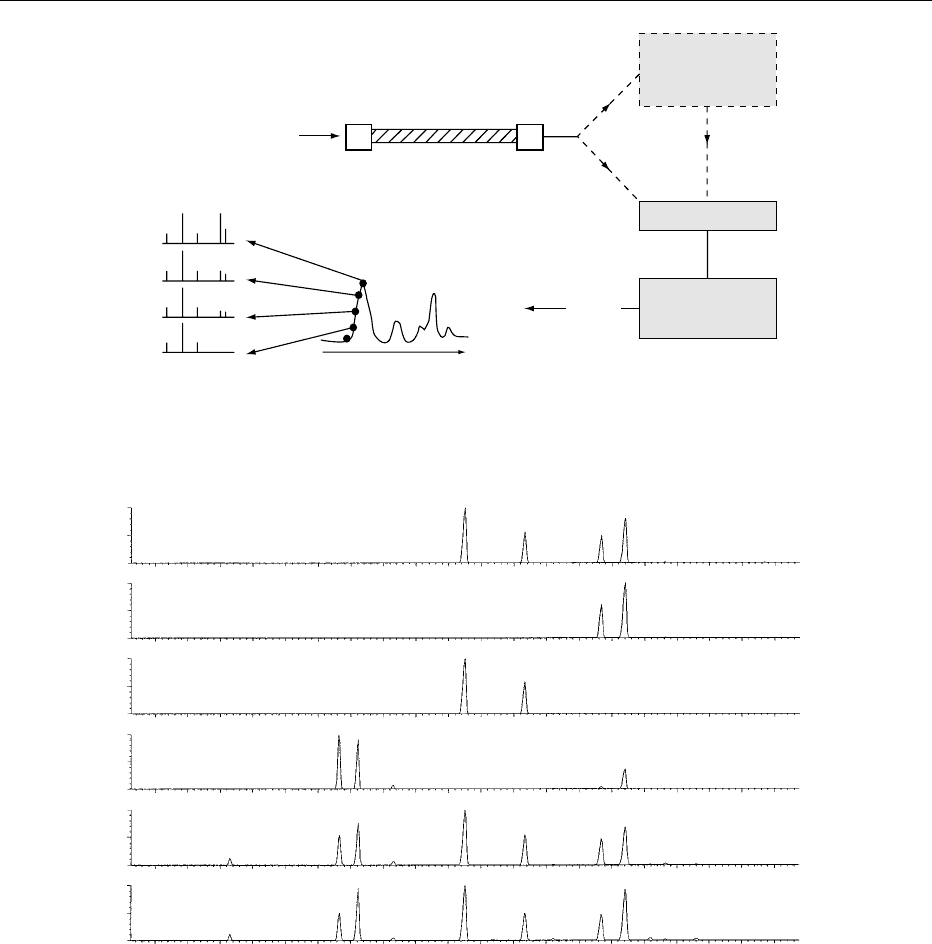
esters containing the moiety –C(H)-CH
2
-CH
2
-
COOMe. Similarly, the ions at 270 and 284 are char-
acteristic molecular ions of methyl palmitate and
margaric acid (methyl heptadecanoate) and isomers
of these molecules. A mass chromatogram is different
from a selected ion-monitoring (SIM) trace (see
below) because the ions of interest are part of a com-
plete mass spectrum: the entire mass spectrum is still
available for examination. In addition to TIC and
mass chromatogram plots, ion intensities may be
summed over a preselected mass range and plotted
against time (for example, m/z 260 320 in Figure 2).
This type of display is sometimes referred to as a
Reconstructed ion chromatogram and is useful for
eliminating intense background ions (for example,
those that arise from solvent peaks during an LC-
MS analysis), or for searching for characteristic ions
that appear in a limited mass range.
0005Whichever chromatographic plotting techniques
are used, each time point in the chromatogram repre-
sents a single mass spectrum that may be examined or
processed either by the operator or automatically
Chromatogram
Retention time
Mass spectra
Mass
spectrometer
Output
Interface
Analog detector
(e.g., UV)
optional
(e.g., HPLC)
Chromatograph
Split
(optional)
Sample in
injector
fig0001 Figure 1 Schematic diagram of the chromatography–mass spectrometry process. HPLC, high-performance liquid chromatography;
UV, ultraviolet. Copyright Institute of Food Research, reproduced with permission.
100
%
0
100
%
0
100
%
0
100
%
0
100
%
0
100
%
0
Sum of m/z 260 −320
m/z 284
m/z 270
m/z 256
m/z 74
Total ion current (TIC)
9.00
10.00 11.00 12.00
13.00 14.00 15.00 16.00 17.00 18.00
Time
17.30
16.58
16.20
16.20
16.20
16.20
16.20
15.83
15.83
15.83
15.83
15.83
14.67
14.67
14.67
14.67
15.10
13.75
13.75
13.75
13.75
12.65
12.65
12.65
12.12
12.12
12.12
11.83
11.83
11.82
10.15
10.15
fig0002 Figure 2 Total ion current (TIC), mass, and summed mass chromatograms of selected ions in the gas chromatography/mass
spectrometry of fatty acid methyl esters. Copyright Institute of Food Research, reproduced with permission.
CHROMATOGRAPHY/Combined Chromotography and Mass Spectrometry 1295
